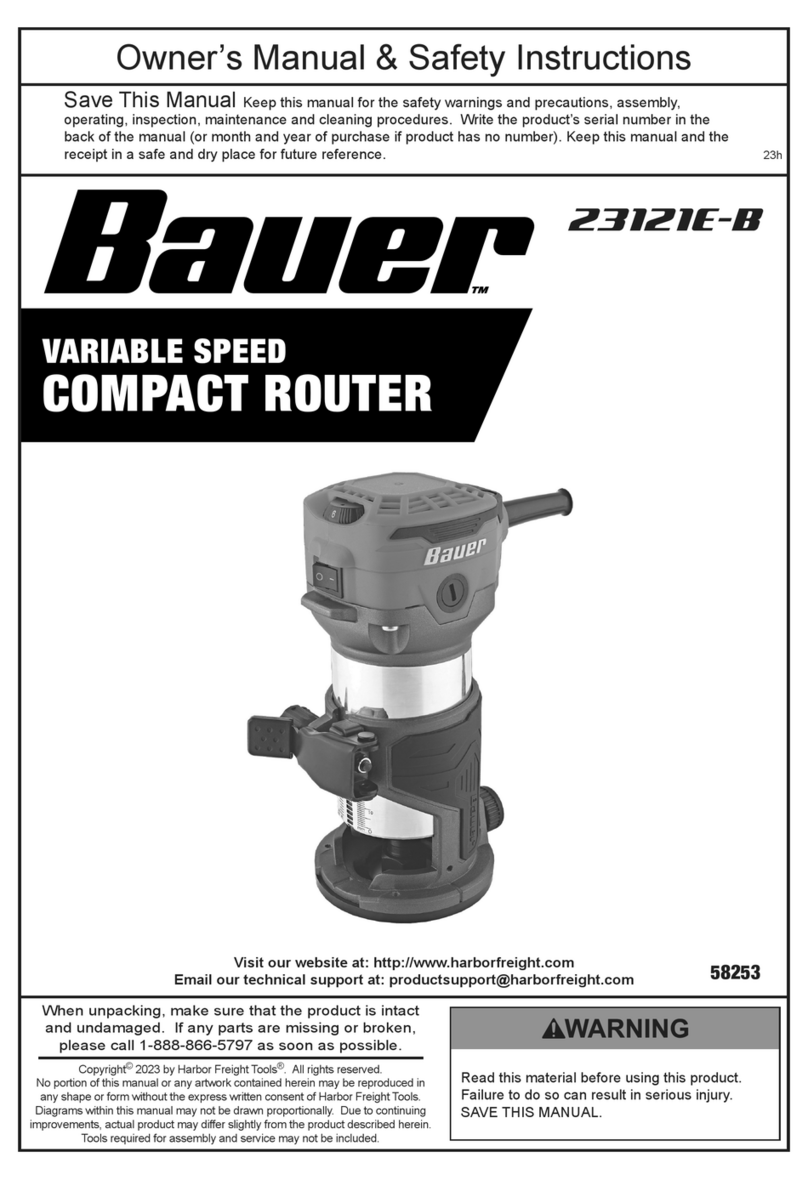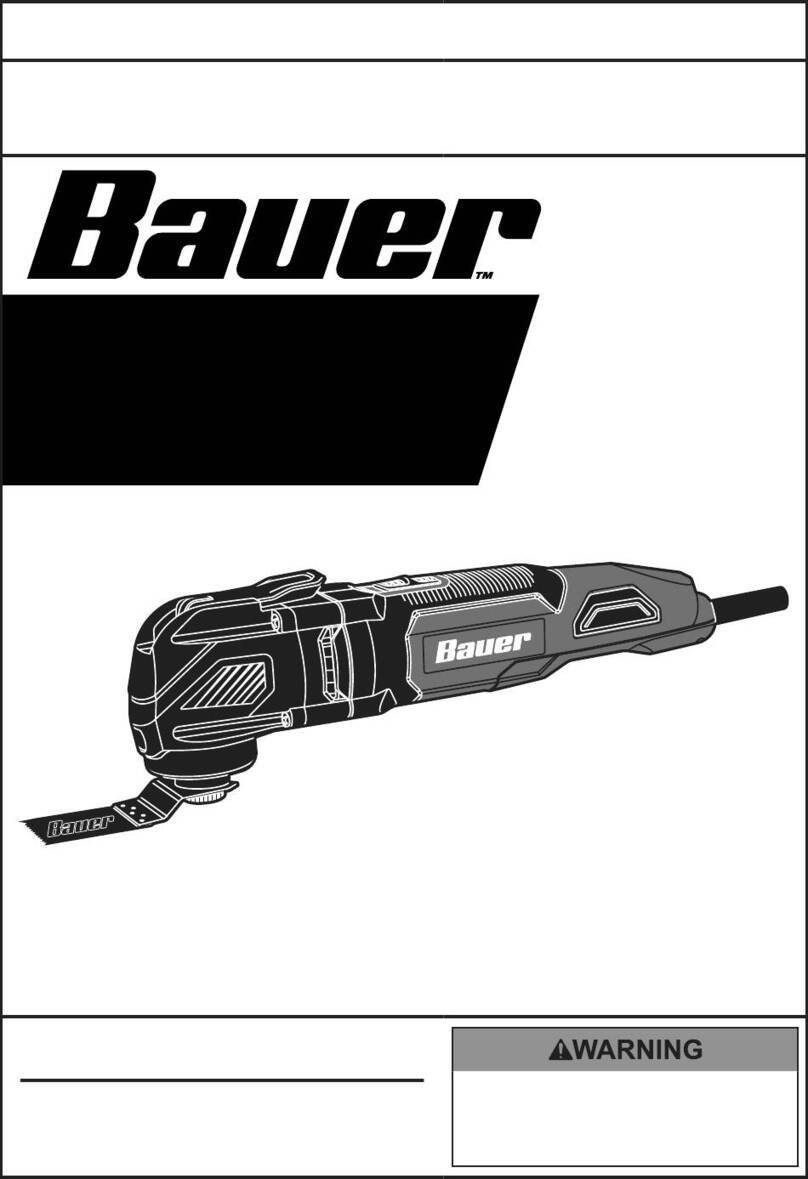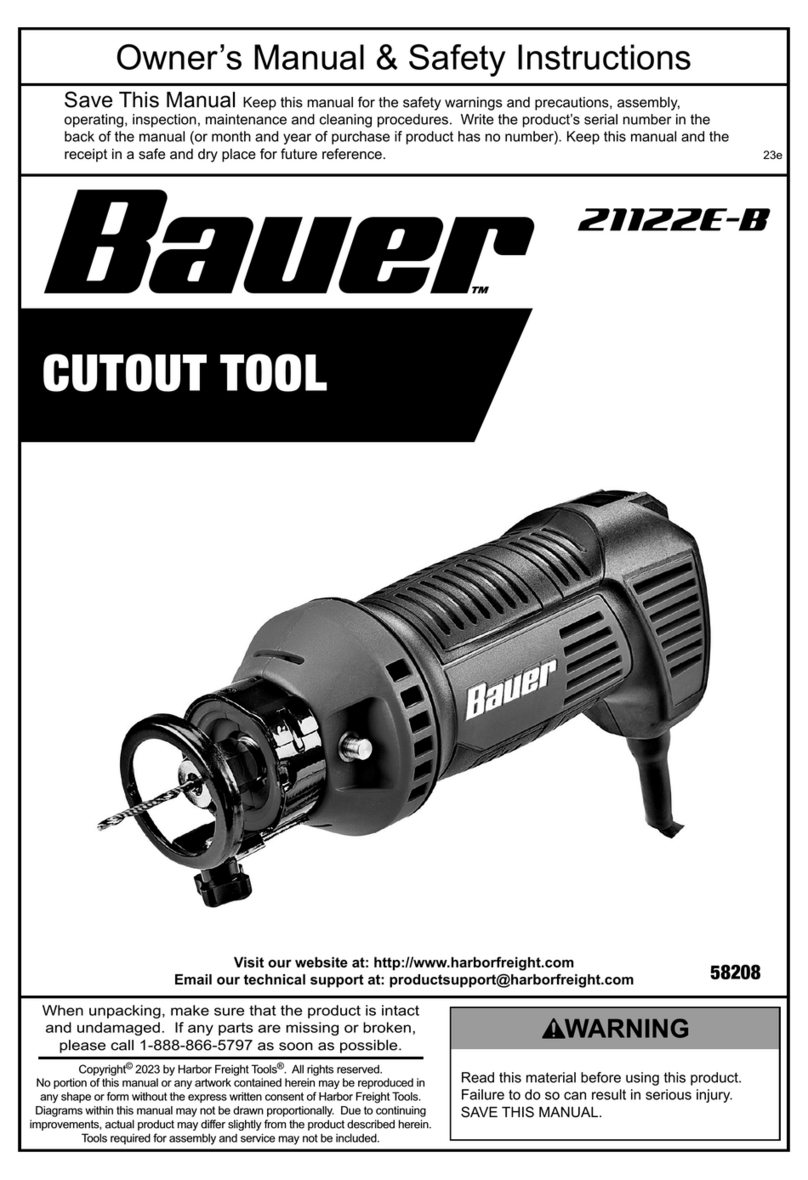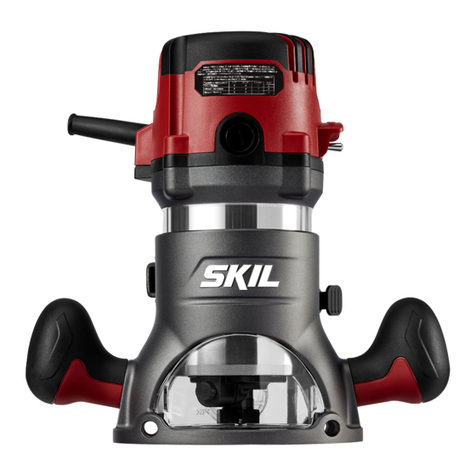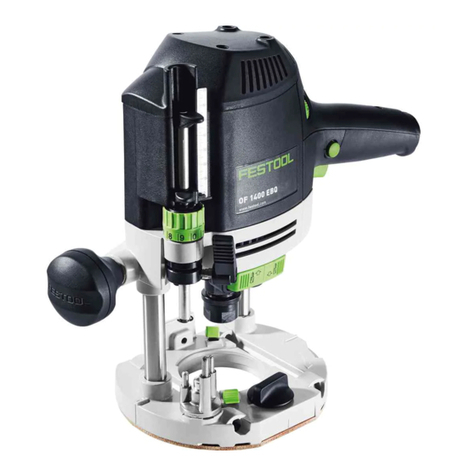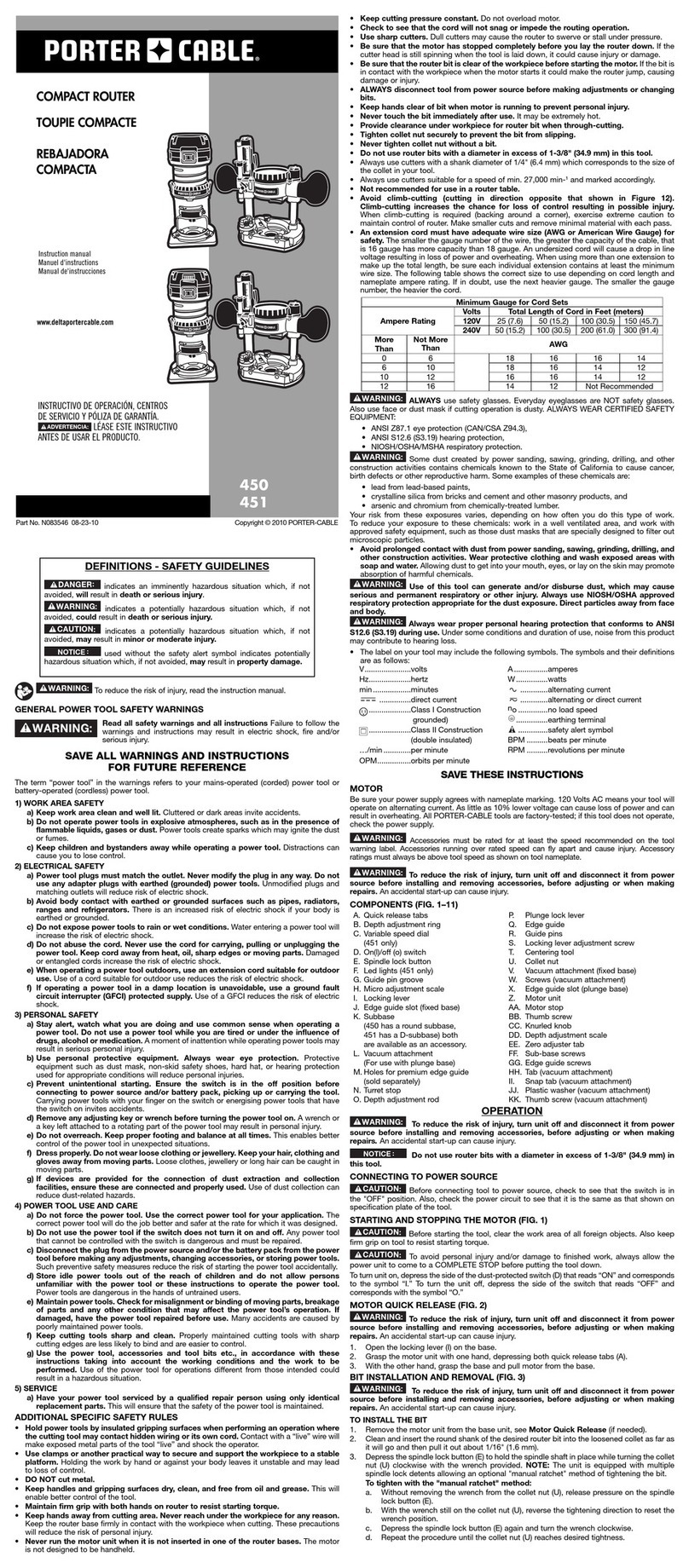Bauer 19121E-B Assembly instructions

Visit our website at: http://www.harborfreight.com
Owner’s Manual & Safety Instructions
Save This Manual Keep this manual for the safety warnings and precautions, assembly,
operating, inspection, maintenance and cleaning procedures. Write the product’s serial number in the
back of the manual near the assembly diagram (or month and year of purchase if product has no number).
Keep this manual and the receipt in a safe and dry place for future reference. 21i
When unpacking, make sure that the product is intact
and undamaged. If any parts are missing or broken,
please call 1-888-866-5797 as soon as possible.
Copyright©2021 by Harbor Freight Tools®. All rights reserved.
No portion of this manual or any artwork contained herein may be reproduced in
any shape or form without the express written consent of Harbor Freight Tools.
Diagrams within this manual may not be drawn proportionally. Due to continuing
improvements, actual product may differ slightly from the product described herein.
Tools required for assembly and service ma y n o t b e i n c l u d e d .
Read this material before using this product.
Failure to do so can result in serious injury.
SAVE THIS MANUAL.

Page 2 For technical questions, please call 1-888-866-5797. Item 58253
SAFETY OPERATION MAINTENANCESETUP
Table of Contents
Safety ........................................................................2
Specifications ............................................................7
Setup .........................................................................7
Operation...................................................................8
Maintenance.............................................................12
Parts List and Diagram.............................................14
Warranty ...................................................................16
WARNING SYMBOLS AND DEFINITIONS
This is the safety alert symbol. It is used to alert you to potential
personal injury hazards. Obey all safety messages that
follow this symbol to avoid possible injury or death.
Indicates a hazardous situation which, if not avoided,
will result in death or serious injury.
Indicates a hazardous situation which, if not avoided,
could result in death or serious injury.
Indicates a hazardous situation which, if not avoided,
could result in minor or moderate injury.
Addresses practices not related to personal injury.
IMPORTANT SAFETY INFORMATION
General Power Tool Safety Warnings
Read all safety warnings, instructions, illustrations and specifications provided with this power tool.
Failure to follow all instructions listed below may result in electric shock, fire and/or serious injury.
Save all warnings and instructions for future reference.
The term “power tool” in the warnings refers to your mains-operated (corded)
power tool or battery-operated (cordless) power tool.
1. Work area safety
a. Keep work area clean and well lit.
Cluttered or dark areas invite accidents.
b. Do not operate power tools in explosive
atmospheres, such as in the presence of
flammable liquids, gases or dust. Power tools
create sparks which may ignite the dust or fumes.
c. Keep children and bystanders away
while operating a power tool. Distractions
can cause you to lose control.

Page 3For technical questions, please call 1-888-866-5797.Item 58253
SAFETYOPERATIONMAINTENANCE SETUP
2. Electrical safety
a. Power tool plugs must match the outlet.
Never modify the plug in any way. Do not use
any adapter plugs with earthed (grounded)
power tools. Unmodified plugs and matching
outlets will reduce risk of electric shock.
b. Avoid body contact with earthed or
grounded surfaces, such as pipes,
radiators, ranges and refrigerators.
There is an increased risk of electric shock
if your body is earthed or grounded.
c. Do not expose power tools to rain or wet
conditions. Water entering a power tool
will increase the risk of electric shock.
d. Do not abuse the cord. Never use the cord
for carrying, pulling or unplugging the power
tool. Keep cord away from heat, oil, sharp
edges or moving parts. Damaged or entangled
cords increase the risk of electric shock.
e. When operating a power tool outdoors,
use an extension cord suitable for outdoor
use. Use of a cord suitable for outdoor
use reduces the risk of electric shock.
f. If operating a power tool in a damp location
is unavoidable, use a ground fault circuit
interrupter (GFCI) protected supply. Use of
a GFCI reduces the risk of electric shock.
3. Personal safety
a. Stay alert, watch what you are doing and
use common sense when operating a
power tool. Do not use a power tool while
you are tired or under the influence of
drugs, alcohol or medication. A moment
of inattention while operating power tools
may result in serious personal injury.
b. Use personal protective equipment. Always
wear eye protection. Protective equipment
such as dust mask, non-skid safety shoes, hard
hat, or hearing protection used for appropriate
conditions will reduce personal injuries.
c. Prevent unintentional starting. Ensure the
switch is in the off-position before connecting
to power source and/or battery pack, picking
up or carrying the tool. Carrying power tools
with your finger on the switch or energizing power
tools that have the switch on invites accidents.
d. Remove any adjusting key or wrench
before turning the power tool on. A wrench
or a key left attached to a rotating part of the
power tool may result in personal injury.
e. Do not overreach. Keep proper footing and
balance at all times. This enables better control
of the power tool in unexpected situations.
f. Dress properly. Do not wear loose clothing
or jewelry. Keep your hair, clothing
and gloves away from moving parts.
Loose clothes, jewelry or long hair
can be caught in moving parts.
g. If devices are provided for the connection
of dust extraction and collection
facilities, ensure these are connected
and properly used. Use of dust collection
can reduce dust-related hazards.
h. Do not let familiarity gained from frequent
use of tools allow you to become
complacent and ignore tool safety
principles. A careless action can cause
severe injury within a fraction of a second.
i. Only use safety equipment that has been
approved by an appropriate standards agency.
Unapproved safety equipment may not provide
adequate protection. Eye protection must be
ANSI-approved and breathing protection
must be NIOSH-approved for the
specific hazards in the work area.
j. Avoid unintentional starting.
Prepare to begin work before turning on the tool.
k. Do not lay the tool down until it has come to
a complete stop. Moving parts can grab the
surface and pull the tool out of your control.
l. When using a handheld power tool,
maintain a firm grip on the tool with
both hands to resist starting torque.
m. Do not depress the spindle lock when
starting or during operation.
n. Do not leave the tool unattended when
it is plugged into an electrical outlet.
Turn off the tool, and unplug it from its
electrical outlet before leaving.
o. This product is not a toy.
Keep it out of reach of children.
p. People with pacemakers should consult their
physician(s) before use. Electromagnetic fields
in close proximity to heart pacemaker could
cause pacemaker interference or pacemaker
failure. In addition, people with pacemakers
should:
• Avoid operating alone.
• Do not use with Trigger locked on.
• Properly maintain and inspect to avoid
electrical shock.
• Properly ground power cord.
Ground Fault Circuit Interrupter (GFCI)
should also be implemented – it prevents
sustained electrical shock.

Page 4 For technical questions, please call 1-888-866-5797. Item 58253
SAFETY OPERATION MAINTENANCESETUP
q. The warnings, precautions, and instructions
discussed in this instruction manual cannot
cover all possible conditions and situations
that may occur. It must be understood by the
operator that common sense and caution are
factors which cannot be built into this product,
but must be supplied by the operator.
4. Power tool use and care
a. Do not force the power tool. Use the correct
power tool for your application. The correct
power tool will do the job better and safer
at the rate for which it was designed.
b. Do not use the power tool if the switch
does not turn it on and off. Any power
tool that cannot be controlled with the switch
is dangerous and must be repaired.
c. Disconnect the plug from the power
source and/or remove the battery pack,
if detachable, from the power tool before
making any adjustments, changing
accessories, or storing power tools.
Such preventive safety measures reduce the
risk of starting the power tool accidentally.
d. Store idle power tools out of the reach of
children and do not allow persons unfamiliar
with the power tool or these instructions
to operate the power tool. Power tools are
dangerous in the hands of untrained users.
e. Maintain power tools and accessories.
Check for misalignment or binding of moving
parts, breakage of parts and any other
condition that may affect the power tool’s
operation. If damaged, have the power tool
repaired before use. Many accidents are
caused by poorly maintained power tools.
f. Keep cutting tools sharp and clean. Properly
maintained cutting tools with sharp cutting edges
are less likely to bind and are easier to control.
g. Use the power tool, accessories and tool bits
etc. in accordance with these instructions,
taking into account the working conditions
and the work to be performed. Use of the
power tool for operations different from those
intended could result in a hazardous situation.
h. Keep handles and grasping surfaces
dry, clean and free from oil and grease.
Slippery handles and grasping surfaces
do not allow for safe handling and control
of the tool in unexpected situations.
5. Service
a. Have your power tool serviced by a
qualified repair person using only identical
replacement parts. This will ensure that
the safety of the power tool is maintained.
b. Maintain labels and nameplates on the tool.
These carry important safety information.
If unreadable or missing, contact
Harbor Freight Tools for a replacement.
6. Safety instructions for routers
a. Hold the power tool by insulated gripping
surfaces only, because the cutter may contact
its own cord. Cutting a “live” wire may make
exposed metal parts of the power tool “live”
and could give the operator an electric shock.
b. Use clamps or another practical way to
secure and support the workpiece to a
stable platform. Holding the work by
your hand or against the body leaves it
unstable and may lead to loss of control.
c. Let bit cool before touching, changing
or adjusting it. Bits heat up dramatically
while in use, and can burn you.
7. Vibration Safety
This tool vibrates during use.
Repeated or long-term exposure to vibration may
cause temporary or permanent physical injury,
particularly to the hands, arms and shoulders.
To reduce the risk of vibration-related injury:
a. Anyone using vibrating tools regularly or for
an extended period should first be examined
by a doctor and then have regular medical
check-ups to ensure medical problems are not
being caused or worsened from use. Pregnant
women or people who have impaired blood
circulation to the hand, past hand injuries,
nervous system disorders, diabetes, or
Raynaud’s Disease should not use this tool.
If you feel any symptoms related to
vibration (such as tingling, numbness,
and white or blue fingers), seek medical
advice as soon as possible.
b. Do not smoke during use. Nicotine reduces
the blood supply to the hands and fingers,
increasing the risk of vibration-related injury.
c. Wear suitable gloves to reduce the
vibration effects on the user.
d. Use tools with the lowest vibration
when there is a choice.
e. Include vibration-free periods each day of work.
f. Grip tool as lightly as possible (while still keeping
safe control of it). Let the tool do the work.
g. To reduce vibration, maintain the tool as
explained in this manual. If any abnormal
vibration occurs, stop use immediately.
SAVE THESE INSTRUCTIONS.

Page 5For technical questions, please call 1-888-866-5797.Item 58253
SAFETYOPERATIONMAINTENANCE SETUP
Grounding
TO PREVENT ELECTRIC SHOCK AND DEATH FROM
INCORRECT GROUNDING WIRE CONNECTION:
Check with a qualified electrician if you are in doubt as to whether the outlet is properly
grounded. Do not modify the power cord plug provided with the tool. Never remove the
grounding prong from the plug. Do not use the tool if the power cord or plug is damaged. If damaged, have
it repaired by a service facility before use. If the plug will not fit the outlet, have a proper outlet installed by
a qualified electrician.
Grounded Tools: Tools with Three Prong Plugs
3-Prong Plug and Outlet
1. Tools marked with “Grounding Required” have
a three wire cord and three prong grounding
plug. The plug must be connected to a properly
grounded outlet. If the tool should electrically
malfunction or break down, grounding provides
a low resistance path to carry electricity away
from the user, reducing the risk of electric shock.
(See 3-Prong Plug and Outlet.)
2. The grounding prong in the plug is connected
through the green wire inside the cord to the
grounding system in the tool. The green wire
in the cord must be the only wire connected to
the tool’s grounding system and must never
be attached to an electrically “live” terminal.
(See 3-Prong Plug and Outlet.)
3. The tool must be plugged into an appropriate outlet,
properly installed and grounded in accordance
with all codes and ordinances. The plug and outlet
should look like those in the preceding illustration.
(See 3-Prong Plug and Outlet.)
Double Insulated Tools: Tools with Two Prong Plugs
Outlets for 2-Prong Plug
1. Tools marked “Double Insulated” do not
require grounding. They have a special
double insulation system which satisfies
OSHA requirements and complies with
the applicable standards of Underwriters
Laboratories, Inc., the Canadian Standard
Association, and the National Electrical Code.
2. Double insulated tools may be used in either of the
120 volt outlets shown in the preceding illustration.
(See Outlets for 2-Prong Plug.)

Page 6 For technical questions, please call 1-888-866-5797. Item 58253
SAFETY OPERATION MAINTENANCESETUP
Extension Cords
1. Grounded tools require a three wire extension cord.
Double Insulated tools can use either
a two or three wire extension cord.
2. As the distance from the supply outlet increases,
you must use a heavier gauge extension cord.
Using extension cords with inadequately sized wire
causes a serious drop in voltage, resulting in loss of
power and possible tool damage. (See Table A.)
3. The smaller the gauge number of the wire, the
greater the capacity of the cord. For example,
a 14 gauge cord can carry a higher current
than a 16 gauge cord. (See Table A.)
4. When using more than one extension cord
to make up the total length, make sure
each cord contains at least the minimum
wire size required. (See Table A.)
5. If you are using one extension cord for more
than one tool, add the nameplate amperes
and use the sum to determine the required
minimum cord size. (See Table A.)
6. If you are using an extension cord outdoors, make
sure it is marked with the suffix “W-A” (“W” in
Canada) to indicate it is acceptable for outdoor use.
7. Make sure the extension cord is properly wired
and in good electrical condition. Always replace
a damaged extension cord or have it repaired
by a qualified electrician before using it.
8. Protect the extension cords from sharp objects,
excessive heat, and damp or wet areas.
TABLE A: RECOMMENDED MINIMUM WIRE
GAUGE FOR EXTENSION CORDS* (120/240 VOLT)
NAMEPLATE
AMPERES
(at full load)
EXTENSION CORD
LENGTH
25´ 50´ 75´ 100´ 150´
0 – 2.0 18 18 18 18 16
2.1 – 3.4 18 18 18 16 14
3.5 – 5.0 18 18 16 14 12
5.1 – 7.0 18 16 14 12 12
7.1 – 12.0 18 14 12 10 -
12.1 – 16.0 14 12 10 - -
16.1 – 20.0 12 10 - - -
* Based on limiting the line voltage drop to five volts at
150% of the rated amperes.
Symbology
Double Insulated
VVolts
~Alternating Current
AAmperes
n0xxxx/min. No Load Revolutions per Minute (RPM)
WARNING marking concerning Risk
of Eye Injury. Wear ANSI-approved
safety goggles with side shields.
Read the manual before
set-up and/or use.
WARNING marking
concerning Risk of Fire.
Do not cover ventilation ducts.
Keep flammable objects away.
WARNING marking concerning
Risk of Electric Shock.
Properly connect power cord
to appropriate outlet.

Page 7For technical questions, please call 1-888-866-5797.Item 58253
SAFETYOPERATIONMAINTENANCE SETUP
Specifications
Electrical Rating 120 VAC / 60 Hz / 6.5 A
n0Load Speed 10,000 – 30,000/min
Collet Size 1/4"
Max. Accessory Diameter 1-3/8″
Setup - Before Use:
Read the ENTIRE IMPORTANT SAFETY INFORMATION section at the beginning of this
manual including all text under subheadings therein before set up or use of this product.
Note: For additional information regarding the parts listed in the
following pages, refer to Parts List and Diagram on page 14.
Functions
ON/OFF
Switch
Fence
Base
Fence
Bracket
Power
Cord
Wing
Nut
Attachment
Knob
Depth
Adjustment
Screw
Speed
Control Dial
Spindle
Lock
Locking
Lever
Depth
Scale

Page 8 For technical questions, please call 1-888-866-5797. Item 58253
SAFETY OPERATION MAINTENANCESETUP
Operating Instructions
Read the ENTIRE IMPORTANT SAFETY INFORMATION section at the beginning of this
manual including all text under subheadings therein before set up or use of this product.
Tool Set Up
TO PREVENT SERIOUS INJURY FROM ACCIDENTAL OPERATION:
Make sure that the Power Switch is in the off-position and unplug the tool from
its electrical outlet before performing any procedure in this section.
Installing the Router Bit
Note: This tool includes a 1/4″collet. Use
only bits that have a 1/4″shank.
Note: Do not use a bit with a cutting diameter
larger than the opening in the base.
1. Use only bits that are marked as suitable
for the type of material being cut.
2. Use only bits that are marked with a speed equal
or higher than the speed marked on the tool.
3. Unplug the Router from the electrical outlet.
4. Release the Locking Lever and use the
Depth Adjustment Screw to move the
Base down to expose the Collet Nut.
5. Press the Spindle Lock in to keep
the Spindle from turning.
6. Using the Large Wrench included, loosen
the Collet Nut, but do not remove.
7. If there is already a bit in the Collet, remove it.
8. Push the shank end of the new bit (sold
separately) into the opening in the Collet
Nut. There may be some resistance, so
make sure that it goes in all the way.
9. Pull out bit slightly so that there is
1/16″gap at bottom of bit.
10. While holding in the Spindle Lock, tighten
the Collet Nut with the Large Wrench.
Adjusting Cutting Depth
Set the depth of cut using the scale
marked on the side of the Router.
1. Install the router bit as previously described.
2. Unplug Router from electrical outlet
before making any adjustments.
3. Release the Locking Lever and use the Depth
Adjustment Screw to move the Base down so
the router bit is retracted within the Base.
4. Place the Base on a flat surface, and
slide the Router down in the Base
until the tip of the bit contacts the work
surface. Tighten the Locking Lever.
5. The depth scale on the Housing now shows
the starting position. This starting position
will vary depending on the bit used.
6. Add the desired depth of cut to the starting position.
For example, if the starting position is 1/2"
and the desired depth of cut is 1/4", the
correct adjustment on the scale is 3/4".
7. Release the Locking Lever, and use the Depth
Adjustment Screw to move the Housing up
until the scale shows the correct reading;
in this example 3/4". Tighten the Locking Lever.
8. Make a test cut on a piece of scrap material
to ensure that the adjustment is correct.

Page 9For technical questions, please call 1-888-866-5797.Item 58253
SAFETYOPERATIONMAINTENANCE SETUP
Installing the Fence
Use the Fence to make cuts parallel to
the edge of a workpiece, or following a
guide clamped onto the workpiece.
1. Install the Fence Bracket with the Fence
facing inward, and the flanges down.
2. Using the Attachment Knob, attach
the Fence Assembly to the Router,
as shown in Figure A.
3. After measuring the proper distance
from the router bit to the Fence, tighten
the Fence using the Wing Nut.
4. Adjust the cutting depth as described in
Adjusting Cutting Depth on page 8.
5. Make a test cut on a piece of scrap material
to ensure that the adjustment is correct.
Fence
Attachment
Knob
Wing
Nut
Figure A: Installing the Fence
Setting up a Temporary Guide
Clamp a temporary guide to the workpiece
to make a straight cut which does not
parallel the edge of the workpiece.
1. Clamp a suitable straight board across the
workpiece parallel to the desired location of the cut.
2. Install the Fence Assembly with the Fence
facing outward and up, as shown in Figure B.
3. After measuring the proper distance from the
router bit to the temporary guide, tighten the Fence
using the Attachment Knob and Wing Nut.
4. Make a test cut on a piece of scrap material
to ensure that the adjustment is correct. Fence
Attachment
Knob
Fence
Bracket
Wing
Nut
Figure B: Fence Installation for
Use with a Temporary Guide

Page 10 For technical questions, please call 1-888-866-5797. Item 58253
SAFETY OPERATION MAINTENANCESETUP
Circle Cutting
Use the center hole in the Fence as a
pivot point when cutting circles.
1. Install the Fence as shown in Figure C.
2. Set the distance from the center hole in the
Fence to the far edge of the router bit equal to
the radius of the circle. Lock the Fence in place
with the Attachment Knob and Wing Nut.
3. Align the center hole in the Fence with
the center point of the circle.
4. Drive a nail through the center hole
to secure the Fence in place.
Fence
Attachment
Knob
Center
Hole
Fence
Bracket
Wing
Nut
Figure C: Fence Installation for Circle Cutting
Workpiece and Work Area Set Up
1. Designate a work area that is clean and well lit.
The work area must not allow access by children
or pets to prevent distraction and injury.
2. Route the power cord along a safe route to reach
the work area without creating a tripping hazard or
exposing the power cord to possible damage. The
power cord must reach the work area with enough
extra length to allow free movement while working.
3. Secure loose workpieces using a vise or clamps
(not included) to prevent movement while working.
4. There must not be objects, such as utility lines,
nearby that will present a hazard while working.

Page 11For technical questions, please call 1-888-866-5797.Item 58253
SAFETYOPERATIONMAINTENANCE SETUP
General Operating Instructions
1. Make sure that the Power Switch is in
the off-position, then plug in the tool.
2. Adjust the Router speed to suit the working
material and bit diameter. To adjust speed, turn the
Speed Control Knob from 1 (the slowest speed)
to 6 (the fastest speed). Determine the optimum
speed by testing on a scrap piece of material.
3. Turn the Power Switch on and run the tool for
about 10 seconds before routing to ensure
that all moving parts are running smoothly,
and there are no loose parts, rattles, or
sparking that would indicate damage.
4. When using the Fence: Cut parallel to the edge of
the workpiece with the Fence following the edge.
5. When using a Temporary Guide: Cut with the
Fence following the edge of the temporary guide.
6. When making a Circle Cut: With the nail in
place through the center hole of the Fence,
plunge the router bit into the workpiece and
rotate the Router in a circle around the nail.
Note: The router bit rotates clockwise.
Adjust for this while cutting:
a. For most materials it is best to move the Router
from left to right as facing the workpiece.
1
1. Workpiece
2. Bit revolving direction
Side View
3. Feed direction
3
2
Always route against the rotation direction of the router bit. Move the router
counterclockwise when routing on workpiece edges, move the router clockwise
when routing the inside of the workpiece.
2
3
Top View
1
2
3
1
1
b. When cutting outside edges, move the
Router counterclockwise. When cutting
inside edges, move the Router clockwise.
1
1. Workpiece
2. Bit revolving direction
Side View
3. Feed direction
3
2
Always route against the rotation direction of the router bit. Move the router
counterclockwise when routing on workpiece edges, move the router clockwise
when routing the inside of the workpiece.
2
3
Top View
1
2
3
1
1
WARNING! TO PREVENT SERIOUS INJURY:
The tool will restart automatically if stalled.
7. To prevent accidents, turn off the tool and
unplug it after use. Clean, then store the
tool indoors out of children’s reach.

Page 12 For technical questions, please call 1-888-866-5797. Item 58253
SAFETY OPERATION MAINTENANCESETUP
Maintenance and Servicing
Procedures not specifically explained in this manual must
be performed only by a qualified technician.
TO PREVENT SERIOUS INJURY FROM ACCIDENTAL OPERATION:
Make sure that the Power Switch is in the off-position and unplug the tool from
its electrical outlet before performing any procedure in this section.
TO PREVENT SERIOUS INJURY FROM TOOL FAILURE:
Do not use damaged equipment. If abnormal noise or vibration
occurs, have the problem corrected before further use.
Cleaning, Maintenance, and Lubrication
1. BEFORE EACH USE, inspect the general
condition of the tool. Check for:
• loose hardware
• misalignment or binding of moving parts
• damaged cord/electrical wiring
• cracked or broken parts
• any other condition that may
affect its safe operation.
2. AFTER USE, wipe external surfaces
of the tool with clean cloth.
3. Periodically, wear ANSI-approved
safety goggles and NIOSH-approved
breathing protection and blow dust out of
the motor vents using dry compressed air.
4. Periodically wipe the Collet, Collet Nut, and
router bits with a light oil to prevent rust.
5. Over time, if the performance of the tool diminishes,
or it stops working completely, it may be necessary
to replace the Carbon Brushes.
This procedure must be completed
by a qualified technician.
6. WARNING! TO PREVENT SERIOUS
INJURY: If the supply cord of this power
tool is damaged, it must be replaced only
by a qualified service technician.

Page 13For technical questions, please call 1-888-866-5797.Item 58253
SAFETYOPERATIONMAINTENANCE SETUP
Record Product’s Serial Number Here:
Note: If product has no serial number, record month and year of purchase instead.
Note: Some parts are listed and shown for illustration purposes only, and are not available
individually as replacement parts. Specify UPC 193175434715 when ordering parts.
Troubleshooting
Problem Possible Causes Likely Solutions
Tool will not start. 1. Cord not connected.
2. No power at outlet.
3. Tool’s thermal reset breaker
tripped (if equipped).
4. Internal damage or wear.
(Carbon brushes or
Power Switch, for example.)
1. Check that cord is plugged in.
2. Check power at outlet. If outlet is unpowered,
turn off tool and check circuit breaker.
If breaker is tripped, make sure circuit is right
capacity for tool and circuit has no other loads.
3. Turn off tool and allow to cool.
Press reset button on tool.
4. Have technician service tool.
Tool operates slowly. 1. Forcing tool to work too fast.
2. Extension cord too long or cord
diameter too small.
1. Allow tool to work at its own rate.
2. Eliminate use of extension cord. If an extension
cord is needed, use one with the proper diameter
for its length and load. See Extension Cords
in Grounding section on page 5.
Performance
decreases over time.
1. Carbon brushes worn
or damaged.
2. Router bit dull or damaged.
1. Have qualified technician replace brushes.
2. Use sharp bits. Replace as needed.
Excessive noise
or rattling.
Internal damage or wear. (Carbon
brushes or bearings, for example.)
Have technician service tool.
Overheating. 1. Forcing tool to work too fast.
2. Accessory misaligned.
3. Router bit dull or damaged.
4. Blocked motor housing vents.
5. Motor being strained by long or
small diameter extension cord.
1. Allow tool to work at its own rate.
2. Check and correct accessory to
fence and/or table alignment.
3. Use sharp bits. Replace as needed.
4. Wear ANSI-approved safety goggles and
NIOSH-approved dust mask/respirator while
blowing dust out of motor using compressed air.
5. Eliminate use of extension cord. If an extension
cord is needed, use one with the proper diameter
for its length and load. See Extension Cords
in Grounding section on page 5.
Follow all safety precautions whenever diagnosing or servicing the tool.
Disconnect power supply before service.

Page 14 For technical questions, please call 1-888-866-5797. Item 58253
SAFETY OPERATION MAINTENANCESETUP
Part Description Qty
1 Rating Plate 1
2 Back Cover 1
3 Speed Control 1
4 Terminal Block 1
5 Switch 1
6 Tapping Screw St4.2 x 13 2
7 Power Cord Clamp 1
8 Power Cord Sleeve 1
9 Power Cord 1
10 Spring 2
11 Brush Holder 2
12 Carbon Brush 2
13 Carbon Brush Cap 2
14 Motor Housing 1
15 Stator 1
16 Circlip 1
17 Magnetic Ring 1
18 Washer 5 2
19 Bearing Sleeve 1
20 Bearing 627-2RZ 1
21 Dustproof Ring 1
22 Rotor 1
23 Circlip 1
24 Bearing 6003-2RZ 1
25 Washer 1
26 Bearing Sleeve 1
27 Sleeve 1
Part Description Qty
28 Aluminum Housing 1
29 Tapping Screw St4.2 x 32 4
30 Rubber Grip 1
31 Nut M5 1
32 Locking Lever 1
33 Lever Cover 1
34 Attachment Knob 1
35 Washer 6 2
36 Base 1
37 Base Plate 1
38 Screw M4 x 10 4
39 Depth Adjustment Screw 1
40 Bracket 1
41 Pinion Gear 1
42 Cylindrical Pin Φ4 x 4 1
43 Collet Nut 1
44 Collet 1
45 Spindle Lock Cap 1
46 Spring 1
47 Spindle Lock Pin 1
48 Bolt M6 x 10 1
49 Fence Bracket 1
50 Fence 1
51 Wing Nut 1
52 Small Wrench 1
53 Large Wrench 1
Parts List and Diagram
PLEASE READ THE FOLLOWING CAREFULLY
THE MANUFACTURER AND/OR DISTRIBUTOR HAS PROVIDED THE PARTS LIST AND ASSEMBLY DIAGRAM
IN THIS MANUAL AS A REFERENCE TOOL ONLY. NEITHER THE MANUFACTURER OR DISTRIBUTOR
MAKES ANY REPRESENTATION OR WARRANTY OF ANY KIND TO THE BUYER THAT HE OR SHE IS
QUALIFIED TO MAKE ANY REPAIRS TO THE PRODUCT, OR THAT HE OR SHE IS QUALIFIED TO REPLACE
ANY PARTS OF THE PRODUCT. IN FACT, THE MANUFACTURER AND/OR DISTRIBUTOR EXPRESSLY
STATES THAT ALL REPAIRS AND PARTS REPLACEMENTS SHOULD BE UNDERTAKEN BY CERTIFIED AND
LICENSED TECHNICIANS, AND NOT BY THE BUYER. THE BUYER ASSUMES ALL RISK AND LIABILITY
ARISING OUT OF HIS OR HER REPAIRS TO THE ORIGINAL PRODUCT OR REPLACEMENT PARTS
THERETO, OR ARISING OUT OF HIS OR HER INSTALLATION OF REPLACEMENT PARTS THERETO.
Parts List

Page 15For technical questions, please call 1-888-866-5797.Item 58253
SAFETYOPERATIONMAINTENANCE SETUP
Assembly Diagram
1
2
3
4
6
789
10 11 12 13
14
15
16
19
20
21
22
23
24
25
26
27
28
29
30
33
32
18
31
34
35
36
37
38
43
44
47
46
45
39
40
41
48
49
42
51
50
52 53
5
17
18
35

26541 Agoura Road • Calabasas, CA 91302 • 1-888-866-5797
Limited 90 Day Warranty
Harbor Freight Tools Co. makes every effort to assure that its products meet high quality and durability standards,
and warrants to the original purchaser that this product is free from defects in materials and workmanship for the
period of 90 days from the date of purchase. This warranty does not apply to damage due directly or indirectly,
to misuse, abuse, negligence or accidents, repairs or alterations outside our facilities, criminal activity, improper
installation, normal wear and tear, or to lack of maintenance. We shall in no event be liable for death, injuries
to persons or property, or for incidental, contingent, special or consequential damages arising from the use of
our product. Some states do not allow the exclusion or limitation of incidental or consequential damages, so the
above limitation of exclusion may not apply to you. THIS WARRANTY IS EXPRESSLY IN LIEU OF ALL OTHER
WARRANTIES, EXPRESS OR IMPLIED, INCLUDING THE WARRANTIES OF MERCHANTABILITY AND FITNESS.
To take advantage of this warranty, the product or part must be returned to us with transportation charges
prepaid. Proof of purchase date and an explanation of the complaint must accompany the merchandise.
If our inspection verifies the defect, we will either repair or replace the product at our election or we may
elect to refund the purchase price if we cannot readily and quickly provide you with a replacement. We will
return repaired products at our expense, but if we determine there is no defect, or that the defect resulted
from causes not within the scope of our warranty, then you must bear the cost of returning the product.
This warranty gives you specific legal rights and you may also have other rights which vary from state to state.
Other manuals for 19121E-B
1
This manual suits for next models
1
Table of contents
Other Bauer Wood Router manuals
Popular Wood Router manuals by other brands
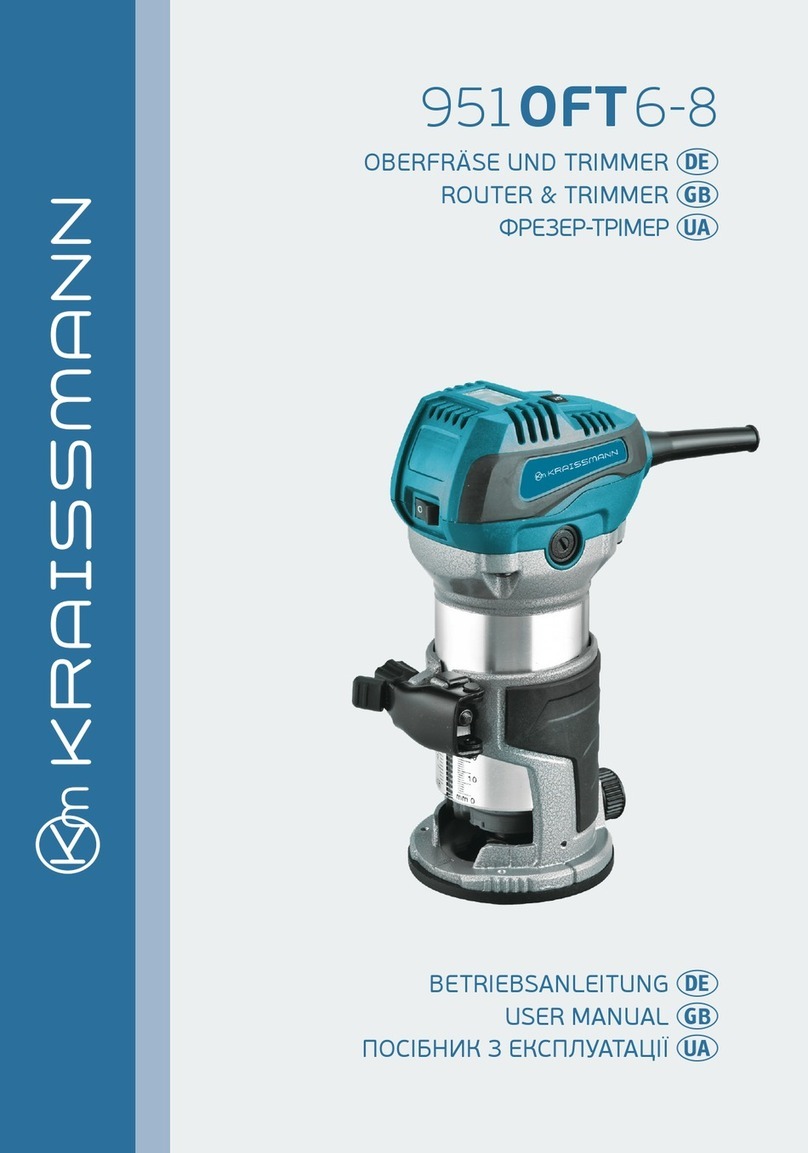
Kraissmann
Kraissmann 951OFT 6-8 user manual

Milwaukee
Milwaukee M18 FUEL 2723-20 Operator's manual
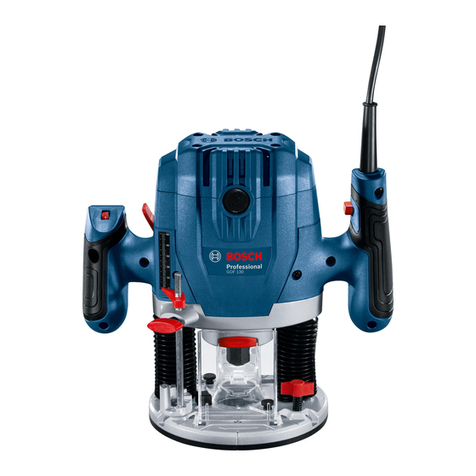
Bosch
Bosch Professional GOF 130 Original instructions
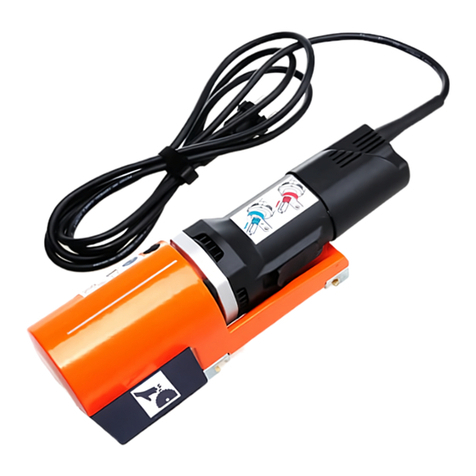
BLUM
BLUM M35.ZS00 Safety, operating and maintenance instructions
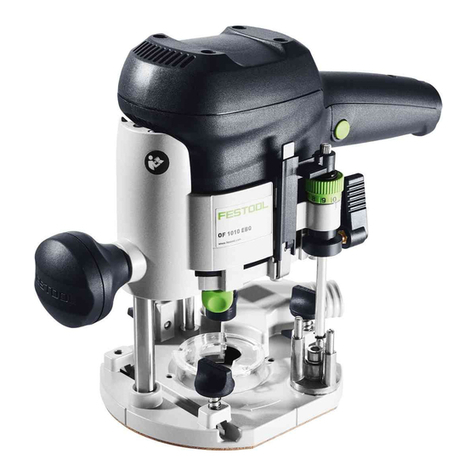
Festool
Festool OF 1010 EQ Original operating manual

Drill Master
Drill Master 62659 Owner's manual & safety instructions
